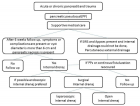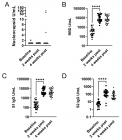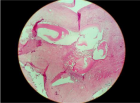Abstract
Research Article
Effect of foot posture on foot-specific health-related quality of life
Bahar Külünkoğlu*, Yasemin Akkubak and Afra Alkan
Published: 10 January, 2018 | Volume 3 - Issue 1 | Pages: 017-023
The purpose of this study was to determine the relationship between Navicular drop (ND) and Hallux valgus (HV) angles and their effects on foot-specific health related quality of life. Sixty female patients with bilateral HV aged between 32-60 participated in this study. The patients with the HV deformity degree of “2” or “3” according to the Manchester scale were included.
HV angle were obtained from standing (weight bearing) bilateral antero-posterior radiographs. HV angle (A angle), intermetatarsal angle (B angle), hallux interphalangeal angle (C angle) were measured. Subtalar pronation was measured the navicular drop (ND) test. ND test were performed for both feet and recorded in millimeters. Foot-specific health related quality of life was measured using the Manhester-Oxford Foot Questionnaire (MOFQ).
There was a strong positive correlation between the ND qtest and the angles A, B, and C for the right foot (rho=0.749, 0.761 and 0.749 p<0.001, respectively,). There was a strong positive correlation between the MOFQ subscales and the angles A, B, and C for the right foot (p<0.001). There was a strong positive correlation between the MOFQ subscales and the angles A, B, and C for the right foot (p<0.001).
In conclusion, there were relationship between ND, HV angular severity and foot-specific health related quality of life. As the HV angular severity increased, there was greater drop in the navicula and reduction in quality of life.
Read Full Article HTML DOI: 10.29328/journal.jsmt.1001022 Cite this Article Read Full Article PDF
Keywords:
Hallux valgus; Navicular drop; Quality of life
References
- Ferrari J, Eiff P, Grayzel J. Hallux valgus deformity (bunion). Consultado el. 2014; 22.
- Mortka K, Lisiński P. Hallux valgus-a case for a physiotherapist or only for a surgeon? Literature review. J Phys Ther Sci. 2015; 27: 3303-3307. Ref.: https://goo.gl/BtCpMH
- Menz HB, Roddy E, Thomas E, Croft PR. Impact of hallux valgus severity on general and foot‐specific health‐related quality of life. Arthritis care & research. 2011; 63: 396-404. Ref.: https://goo.gl/q27sRq
- Dunn J, Link C, Felson D, Crincoli M, Keysor J, et al. Prevalence of foot and ankle conditions in a multiethnic community sample of older adults. Am J Epidemiol. 2004; 159: 491-498. Ref.: https://goo.gl/c4g638
- Cho N, Kim S, Kwon DJ, Kim H. The prevalence of hallux valgus and its association with foot pain and function in a rural Korean community. J Bone Joint Surg Br. 2009; 91: 494-498. Ref.: https://goo.gl/FbR5Ts
- Roddy E, Zhang W, Doherty M. Prevalence and associations of hallux valgus in a primary care population. Arthritis Rheum. 2008; 59: 857-862. Ref.: https://goo.gl/ot6Ncj
- Nguyen US, Hillstrom HJ, Li W, Dufour AB, Kiel DP, et al. Factors associated with hallux valgus in a population-based study of older women and men: the MOBILIZE Boston Study. Osteoarthritis and cartilage. 2010; 18: 41-46. Ref.: https://goo.gl/966pAf
- Nix S, Smith M, Vicenzino B. Prevalence of hallux valgus in the general population: A systematic review and meta-analysis. J Foot Ankle Res. 2010; 3: 21. Ref.: https://goo.gl/7mtzJe
- Perera A, Mason L, Stephens M. The pathogenesis of hallux valgus. The Journal of Bone & Joint Surgery. 2011; 93: 1650-1961. Ref.: https://goo.gl/1StQJC
- Coughlin MJ, Jones CP. Hallux valgus: demographics, etiology, and radiographic assessment. Foot Ankle Int. 2007; 28: 759-777. Ref.: https://goo.gl/Y4VHNT
- Snook AG. The relationship between excessive pronation as measured by navicular drop and isokinetic strength of the ankle musculature. Foot Ankle Int. 2001; 22: 234-240. Ref.: https://goo.gl/sZREBU
- Nam KS, Kwon JW, Kwon OY. The relationship between activity of abductor hallucis and navicular drop in the one-leg standing position. Journal of physical therapy science. 2012; 24: 1103-1106. Ref.: https://goo.gl/n53YNc
- Steinberg N, Finestone A, Noff M, Zeev A, Dar G. Relationship between lower extremity alignment and hallux valgus in women. Foot & ankle international. 2013; 34: 824-831. Ref.: https://goo.gl/2ccusV
- Abhishek A, Roddy E, Zhang W, Doherty M. Are hallux valgus and big toe pain associated with impaired quality of life? A cross-sectional study. Osteoarthritis and Cartilage. 2010; 18: 923-926. Ref.: https://goo.gl/XNbGEz
- Nix SE, Vicenzino BT, Smith MD. Foot pain and functional limitation in healthy adults with hallux valgus: a cross-sectional study. BMC Musculoskelet Disord. 2012; 13: 197. Ref.: https://goo.gl/m7NMqc
- Nix SE, Vicenzino BT, Collins NJ, Smith MD. Gait parameters associated with hallux valgus: a systematic review. J Foot Ankle Res. 2013; 6: 9. Ref.: https://goo.gl/pDymvW
- Saro C, Jensen I, Lindgren U, Felländer-Tsai L. Quality-of-life outcome after hallux valgus surgery. Qual Life Res. 2007; 16: 731-738. Ref.: https://goo.gl/cbyJhY
- Garrow AP, Papageorgiou A, Silman AJ, Thomas E, Jayson MI, et al. The grading of hallux valgus: the Manchester Scale. J Am Podiatr Med Assoc. 2001; 91: 74-78. Ref.: https://goo.gl/K8X91d
- Menz HB, Munteanu SE. Radiographic validation of the Manchester scale for the classification of hallux valgus deformity. Rheumatology (Oxford). 2005; 44: 1061-1066. Ref.: https://goo.gl/iLxPhA
- Loudon JK, Jenkins W, Loudon KL. The relationship between static posture and ACL injury in female athletes. Journal of Orthopaedic & Sports Physical Therapy. 1996; 24: 91-97. Ref.: https://goo.gl/uobH5L
- Vinicombe A, Raspovic A, Menz HB. Reliability of navicular displacement measurement as a clinical indicator of foot posture. J Am Podiatr Med Assoc. 2001; 91: 262-268. Ref.: https://goo.gl/qG5KKS
- Dawson J, Coffey J, Doll H, Lavis G, Cooke P, et al. A patient-based questionnaire to assess outcomes of foot surgery: validation in the context of surgery for hallux valgus. Qual Life Res. 2006; 15: 1211-1222. Ref.: https://goo.gl/sKjJKh
- Glasoe WM, Nuckley DJ, Ludewig PM. Hallux valgus and the first metatarsal arch segment: a theoretical biomechanical perspective. Phys Ther. 2010; 90: 110-120. Ref.: https://goo.gl/bz9t3z
- Mueller M, Host J, Norton B. Navicular drop as a composite measure of excessive pronation. J Am Podiatr Med Assoc. 1993; 83: 198-202. Ref.: https://goo.gl/ZU1Si1
- Woodford-Rogers B, Cyphert L, Denegar CR. Risk factors for anterior cruciate ligament injury in high school and college athletes. J Athl Train. 1994; 29: 343. Reg.: https://goo.gl/ut64F4
- Komeda T, Tanaka Y, Takakura Y, Fujii T, Samoto N, et al. Evaluation of the longitudinal arch of the foot with hallux valgus using a newly developed two-dimensional coordinate system. Journal of orthopaedic science. 2001; 6: 110-118. Ref.: https://goo.gl/9Bb52t
- Dawson J, Doll H, Coffey J, Jenkinson C. Responsiveness and minimally important change for the Manchester-Oxford foot questionnaire (MOXFQ) compared with AOFAS and SF-36 assessments following surgery for hallux valgus. Osteoarthritis and cartilage. 2007; 15: 918-931. Ref.: https://goo.gl/QrSzLk
- Taspinar O, Kabayel DD, Ozdemir F, Tuna H, Keskin Y, et al. Comparing the efficacy of exercise, internal and external shoe modification in pes planus: A clinical and pedobarographic study. J Back Musculoskelet Rehabil. 2017; 30: 255-263. Ref.: https://goo.gl/z5VB4Q
- González-Sánchez M, Velasco-Ramos E, Muñoz MR, Cuesta-Vargas AI. Relationship between patient-reported outcome measures (PROM) and three measures of foot-ankle alignment in patients with metatarsal head pain: a cross-sectional study. J Foot Ankle Res. 2016; 9: 49. Ref.: https://goo.gl/Fy8b22
Similar Articles
-
Vertebral pain syndrome and physical performance assessing in older women with vertebral fracturesGrygorieva Nataliia*, Povorozyuk Vladyslav,Rybina Olena. Vertebral pain syndrome and physical performance assessing in older women with vertebral fractures. . 2017 doi: 10.29328/journal.jsmt.1001015; 2: 109-117
-
Effect of foot posture on foot-specific health-related quality of lifeBahar Külünkoğlu*,Yasemin Akkubak,Afra Alkan. Effect of foot posture on foot-specific health-related quality of life. . 2018 doi: 10.29328/journal.jsmt.1001022; 3: 017-023
-
Hypothermia of the brain - a prospective method for preventing the development of complications of sports craniocerebral injuriesOleg Shevelev*,Smolensky AV,Mengistu EM,Yuriev MY. Hypothermia of the brain - a prospective method for preventing the development of complications of sports craniocerebral injuries. . 2022 doi: 10.29328/journal.jsmt.1001055; 7: 006-007
-
Improving “quality of life” through exercise and proper nutritionRosa Grazia Bellomo,Raoul Saggini,Claudia Barbato*. Improving “quality of life” through exercise and proper nutrition. . 2022 doi: 10.29328/journal.jsmt.1001057; 7: 010-015
-
Effectiveness of physical rehabilitation on sphygmography and blood pressureGrashchenkova АN*,Puzin SN,Bogova ОТ. Effectiveness of physical rehabilitation on sphygmography and blood pressure. . 2023 doi: 10.29328/journal.jsmt.1001063; 8: 001-003
-
Effects of Physiotherapy Care in the Postoperative of Total Hip Arthroplasty: An Integrative ReviewWeslley Barbosa Sales*, Rômulo Claudino Sales e Rodrigues Costa, José Vinicius Bulhões da Silva. Effects of Physiotherapy Care in the Postoperative of Total Hip Arthroplasty: An Integrative Review. . 2024 doi: 10.29328/journal.jsmt.1001077; 9: 022-026
Recently Viewed
-
Improvement of the Cognitive Abilities in a Chronic Generalized Anxiety Disorder and Moderate Depression Case using a Novel Integrated Approach: The Cognitome ProgramMohita Shrivastava*. Improvement of the Cognitive Abilities in a Chronic Generalized Anxiety Disorder and Moderate Depression Case using a Novel Integrated Approach: The Cognitome Program. J Neurosci Neurol Disord. 2024: doi: 10.29328/journal.jnnd.1001100; 8: 069-089
-
Neuroprotective Effect of 7,8-dihydroxyflavone in a Mouse Model of HIV-Associated Neurocognitive Disorder (HAND)Tapas K Makar, Joseph Bryant, Bosung Shim, Kaspar Keledjian, Harry Davis, Manik Ghosh, Ajay Koirala, Ishani Ghosh, Shreya Makar, Alonso Heredia, Malcolm Lane, J Marc Simard, Robert C Gallo, Volodymyr Gerzanich*, Istvan Merchenthaler*. Neuroprotective Effect of 7,8-dihydroxyflavone in a Mouse Model of HIV-Associated Neurocognitive Disorder (HAND). J Neurosci Neurol Disord. 2024: doi: 10.29328/journal.jnnd.1001101; 8: 090-105
-
Adult Neurogenesis: A Review of Current Perspectives and Implications for Neuroscience ResearchAlex, Gideon S*,Olanrewaju Oluwaseun Oke,Joy Wilberforce Ekokojde,Tolulope Judah Gbayisomore,Martina C. Anene-Ogbe,Farounbi Glory,Joshua Ayodele Yusuf. Adult Neurogenesis: A Review of Current Perspectives and Implications for Neuroscience Research. J Neurosci Neurol Disord. 2024: doi: 10.29328/journal.jnnd.1001102; 8: 106-114
-
Analysis of Psychological and Physiological Responses to Snoezelen Multisensory StimulationLucia Ludvigh Cintulova,Jerzy Rottermund,Zuzana Budayova. Analysis of Psychological and Physiological Responses to Snoezelen Multisensory Stimulation. J Neurosci Neurol Disord. 2024: doi: 10.29328/journal.jnnd.1001103; 8: 115-125
-
Sexual Dimorphism in the Length of the Corpus Callosum in CadaverShahnaj Pervin*,Nasaruddin A,Irfan M,Annamalai L. Sexual Dimorphism in the Length of the Corpus Callosum in Cadaver. J Neurosci Neurol Disord. 2024: doi: 10.29328/journal.jnnd.1001104; 8: 126-129
Most Viewed
-
Evaluation of Biostimulants Based on Recovered Protein Hydrolysates from Animal By-products as Plant Growth EnhancersH Pérez-Aguilar*, M Lacruz-Asaro, F Arán-Ais. Evaluation of Biostimulants Based on Recovered Protein Hydrolysates from Animal By-products as Plant Growth Enhancers. J Plant Sci Phytopathol. 2023 doi: 10.29328/journal.jpsp.1001104; 7: 042-047
-
Sinonasal Myxoma Extending into the Orbit in a 4-Year Old: A Case PresentationJulian A Purrinos*, Ramzi Younis. Sinonasal Myxoma Extending into the Orbit in a 4-Year Old: A Case Presentation. Arch Case Rep. 2024 doi: 10.29328/journal.acr.1001099; 8: 075-077
-
Feasibility study of magnetic sensing for detecting single-neuron action potentialsDenis Tonini,Kai Wu,Renata Saha,Jian-Ping Wang*. Feasibility study of magnetic sensing for detecting single-neuron action potentials. Ann Biomed Sci Eng. 2022 doi: 10.29328/journal.abse.1001018; 6: 019-029
-
Pediatric Dysgerminoma: Unveiling a Rare Ovarian TumorFaten Limaiem*, Khalil Saffar, Ahmed Halouani. Pediatric Dysgerminoma: Unveiling a Rare Ovarian Tumor. Arch Case Rep. 2024 doi: 10.29328/journal.acr.1001087; 8: 010-013
-
Physical activity can change the physiological and psychological circumstances during COVID-19 pandemic: A narrative reviewKhashayar Maroufi*. Physical activity can change the physiological and psychological circumstances during COVID-19 pandemic: A narrative review. J Sports Med Ther. 2021 doi: 10.29328/journal.jsmt.1001051; 6: 001-007

HSPI: We're glad you're here. Please click "create a new Query" if you are a new visitor to our website and need further information from us.
If you are already a member of our network and need to keep track of any developments regarding a question you have already submitted, click "take me to my Query."


















































































































































